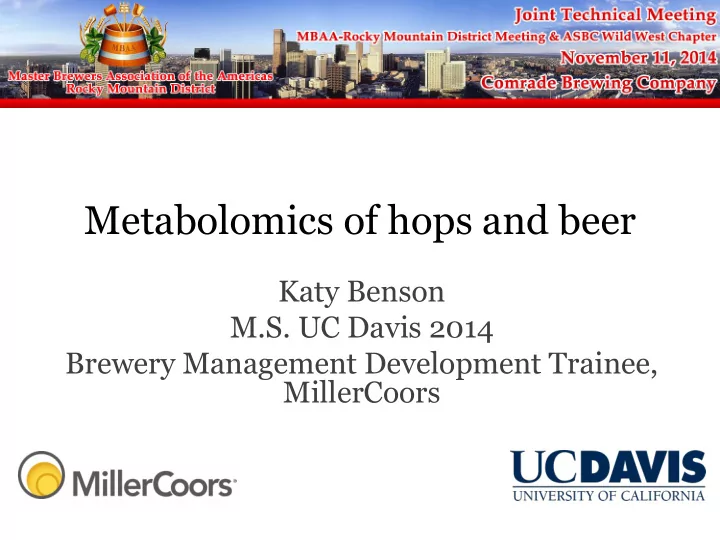

Metabolomics of hops and beer Katy Benson M.S. UC Davis 2014 Brewery Management Development Trainee, MillerCoors
Overview • Definition of metabolite/metabolomics and the process • Inspiration for my research • Hop and commercial beer metabolomics • A novel compound in hops and beer • Brewing trials and analysis • Conclusions
What is metabolomics? NMR: absorption and emission Standard of electromagnetic resonance Metabolite X at Y concentration (quantitative) Metabolite : a product of metabolism, small-molecules. e.g. ethanol, amino acids, sugars, organic acids -ome/-omics : totality, global view. e.g. genome/genomics, proteome/proteomics
Inspiration for my research What metabolites make hops significant? What metabolites make beers different? Can this be detected in a sensory study?
First steps… Non-polar (not water soluble) Polar (water soluble) fraction fraction Metabolite Cascade Magnum 4-Aminobutyrate 9.48 14.37 Acetate 2.05 4.05 Acetone 0.18 0.18 Alanine 9.43 8.37 Arginine 12.05 14.39 Asparagine 114.31 183.77 Aspartate 2.15 3.08 Cascade vs Magnum Choline 6.27 5.68 Creatine phosphate 0.34 0.07 Cytidine 0.14 0.22 Ethanolamine 1.43 0.88 Formate 1.50 1.27 Fructose 31.29 23.85 Fumarate 1.08 2.46 Glucose 56.56 34.37 Glutamine 4.44 3.51 Guanosine 0.38 0.50 Histidine 2.46 3.27 Isoleucine 0.64 0.67 Malate 28.94 56.64 Malonate 0.49 0.91 Methanol 1.49 1.17 Methylsuccinate 2.73 1.21 N-Nitrosodimethylamine 0.41 0.32 O-Phosphocholine 0.56 0.81 Phenylalanine 0.52 0.66 Proline 2.70 3.36 Pale Ale vs IPA Succinate 2.63 5.72 Sucrose 43.63 21.21 Threonine 1.85 2.34 Trigonelline 1.32 2.12 Tryptophan 0.60 0.89 Tyrosine 3.02 2.03 Uridine 0.59 0.54 Valine 1.04 1.84 myo-Inositol 6.33 3.46 (Bamforth 2006) sn-Glycero-3-phosphocholine 1.26 1.26
First steps… Cascade vs Magnum Pale Ale vs IPA Late vs Dry Hopping?
A new compound in hops & beer Trigonelline • Plant alkaloid that has been detected in sources such as coffee and fenugreek ( Kidrič and Košir 2006, Zhou, Chan et al. 2012). • Along with similarly-structured nicotinic acid, implicated as anti-diabetic agents, in that they improve the glucose tolerance in obese diabetics (Yoshinari and Igarashi 2010). • Implicated in various contexts as anti-bacterial, anti-viral, sedative, anti-migraine, and anti-tumor (Zhou, Chan et al. 2012). • Precursor to coffee aroma compound. ~50% carryover from hops to beer
Brewing Trials 5 beers Late-hopped Magnum Late-hopped Cascade Dry-hopped Magnum Dry-hopped Cascade Control (hopless) 5 process samples 1. Start of kettle boil 2. After whirlpool 3. After yeast pitch 4. After fermentation (14 days) 5-gallon brewing set-up at UC Davis. 5. After bottle conditioning (28 days) 4 replicates
Results of Brewing Trials: Metabolites
Results of Brewing Trials: PCA Analysis Principle Component Analysis: statistical analysis to identify important variance Clustering according to global metabolite profile
Results of Brewing Trials: Heat Maps 1. Start of kettle boil 2. After whirlpool 3. After yeast pitch 4. After fermentation (14 days) 5. After bottle conditioning (28 days) = more = less
Conclusions/Further Directions At the detection limit of NMR, the metabolite profile of a final beer is primarily determined during fermentation , with the exception of a few compounds including… Trigonelline is a novel compound in hops and in beer, and shown to carry forward throughout the entirety of the process. Environment and small variations in process have significant impact on the metabolic profile of final beers. The role of hops as contributors of amino acids (FAN) is novel and to be further elucidated.
Acknowledgements Dr. Charlie Bamforth Candy Wallin Dr. Carolyn Slupsky Dr. Ann Spevachek Rachel Gescheidle Tom Nielsen & Gil Sanchez (Sierra Nevada) Toby Eppard Alex Combe Thank you!!
Recommend
More recommend